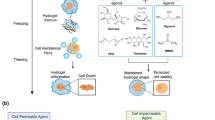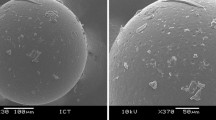Abstract
Mammalian cell-enclosing capsules have been investigated as devices for bioproduction, cell therapy and stem cell research. In this study, carboxymethylcellulose (CMC) with phenol moieties (CMC-Ph), synthesized through the conjugation reaction of CMC and tyramine, was investigated as a material for these types of devices. Subsieve-size capsules of less than 100 μm in diameter were prepared by extruding aqueous CMC-Ph solution into co-flowing liquid paraffin containing H2O2. The capsule diameter was controlled between 60–220 μm by changing the flow rate of liquid paraffin. There was no harmful effect specific for CMC-Ph on mammalian cells enclosed in capsules. Feline kidney cells enclosed in subsieve-size CMC-Ph capsules exhibited 87.0 ± 4.5% viability. In addition, the enclosed cells continued to grow over 13 days of study. These results demonstrated the feasibility of CMC-Ph as a material for subsieve-size cell-enclosing capsules prepared via the droplet breakup technique in a co-flowing water-immiscible fluid.





Similar content being viewed by others
References
Chang TMS, Prakash S (1998) Therapeutic uses of microencapsulated genetically engineered cells. Mol Med Today 4:221–227
Chen G, Yao SJ, Guan YX, Lin DQ (2005) Preparation and characterization of NaCS-CMC/PDMDAAC capsules. Colloids Surf B Biointerfaces 45:136–143
Edgar KJ (2007) Cellulose esters in drug delivery. Cellulose 14:49–64
Gutowska A, Jeong B, Jasionowski M (2001) Injectable gels for tissue engineering. Anat Rec 263:342–349
Hauser O, Prieschl Grassauer E, Salmons B (2004) Encapsulated, genetically modified cells producing in vivo therapeutics. Curr Opin Mol Ther 6:412–420
Heinze T, Koschella A (2005) Carboxymethyl ethers of cellulose and starch - A review. Macromol Symp 223:13–39
Kast CE, Bernkop Schnurch A (2002) Polymer-cysteamine conjugates: new mucoadhesive excipients for drug delivery. Int J Pharm 234:91–99
Lee CS, Chu IM (1997) Characterization of modified alginate-poly-L-lysine microcapsules. Artif Organs 21:1002–1006
Lohr M, Muller P, Karle P, Stange J, Mitzner S, Jesnowski R, Nizze H, Nebe B, Liebe S, Salmons B, Gunzburg WH (1998) Targeted chemotherapy by intratumour injection of encapsulated cells engineered to produce CYP2B1, an ifosfamide activating cytochrome P450. Gene Ther 5:1070–1078
Maguire T, Novik E, Schloss R, Yarmush M (2006) Alginate-PLL microencapsulation: effect on the differentiation of embryonic stem cells into hepatocytes. Biotechnol Bioeng 93:581–591
Mohammed FA (2001) Topical permeation characteristics of diclofenac sodium from NaCMC gels in comparison with conventional gel formulations. Drug Dev Ind Pharm 27:1083–1097
Ogushi Y, Sakai S, Kawakami K (2007) Synthesis of enzymatically-gellable carboxymethylcellulose for biomedical applications. J Biosci Bioeng 104:30–33
Orive G, Ponce S, Hernandez RM, Gascon AR, Igartua M, Pedraz JL (2002) Biocompatibility of microcapsules for cell immobilization elaborated with different type of alginates. Biomaterials 23:3825–3831
Rao YM, Veni JK, Jayasagar G (2001) Formulation and evaluation of diclofenac sodium using hydrophilic matrices. Drug Dev Ind Pharm 27:759–766
Sakai S, Ono T, Ijima H, Kawakami K (2003) Modification of porous aminopropyl-silicate microcapsule membrane by electrically-bonded external anionic polymers. J Biomater Sci Polym Ed 14:643–652
Sakai S, Kawabata K, Ono T, Ijima H, Kawakami K (2004) Preparation of mammalian cell-enclosing subsieve-sized capsules (<100 μm) in a coflowing stream. Biotechnol Bioeng 86:168–173
Sakai S, Kawabata K, Ono T, Ijima H, Kawakami K (2005) Development of mammalian cell-enclosing subsieve-size agarose capsules (<100 μm) for cell therapy. Biomaterials 26:4786–4792
Sakai S, Mu C, Kawabata K, Hashimoto I, Kawakami K (2006a) Biocompatibility of subsieve-size capsules versus conventional-size microcapsules. J Biomed Mater Res 78A:394–398
Sakai S, Hashimoto I, Kawakami K (2006b) Usefulness of flow focusing technology for producing subsieve-size cell enclosing capsules: Application for agarose capsules production. Biochem Eng J 30:218–221
Sakai S, Hashimoto I, Ogushi Y, Kawakami K (2007a) Peroxidase-catalyzed cell-encapsulation in subsieve-size capsules of alginate with phenol moieties in water-immiscible fluid dissolving H2O2. Biomacromolecules 8:2622–2626
Sakai S, Hashimoto I, Kawakami K (2007b) Agarose-gelatin conjugate for adherent cell-enclosing capsules. Biotechnol Lett 29:731–735
Sakai S, Hashimoto I, Kawakami K (2008) Production of cell-enclosing hollow-core agarose microcapsules via jetting in water-immiscible liquid paraffin and formation of embryoid body-like spherical tissues from mouse ES cells enclosed within these microcapsules. Biotechnol Bioeng 99:235–243
Shanbhag A, Barclay B, Koziara J, Shivanand P (2007) Application of cellulose acetate butyrate-based membrane for osmotic drug delivery. Cellulose 14:65–71
Stabler C, Wilks K, Sambanis A, Constantinidis I (2001) The effects of alginate composition on encapsulated betaTC3 cells. Biomaterials 22:1301–10
Uludag H, de Vos P, Tresco PA (2000) Technology of mammalian cell encapsulation. Adv Drug Deliv Rev 42:29–64
Wang X, Wang W, Ma J, Guo X, Yu X, Ma X (2006) Proliferation and differentiation of mouse embryonic stem cells in APA microcapsule: A model for studying the interaction between stem cells and their niche. Biotechnol Prog 22:791–800
Yoshioka T, Hirano R, Shioya T, Kako M (1990) Encapsulation of mammalian cell with chitosan-CMC capsule. Biotechnol Bioeng 35:66–72
Zeng Q, Yu Z, You J, Zhang Q (2007) Efficacy and Safety of Seprafilm for Preventing Postoperative Abdominal Adhesion: Systematic Review and Meta-analysis. World J Surg 31:2125–2131
Acknowledgments
This work was supported by a Grant-in-Aid for Young Scientists (B), (No. 19760554, 2007), and a Grant-in-Aid for the Global COE Program, “Science for Future Molecular Systems”, from the Ministry of Education, Culture, Science, Sports and Technology of Japan.
Author information
Authors and Affiliations
Corresponding author
Rights and permissions
About this article
Cite this article
Sakai, S., Ito, S., Ogushi, Y. et al. Feasibility of carboxymethylcellulose with phenol moieties as a material for mammalian cell-enclosing subsieve-size capsules. Cellulose 15, 723–729 (2008). https://doi.org/10.1007/s10570-008-9221-9
Received:
Accepted:
Published:
Issue Date:
DOI: https://doi.org/10.1007/s10570-008-9221-9




